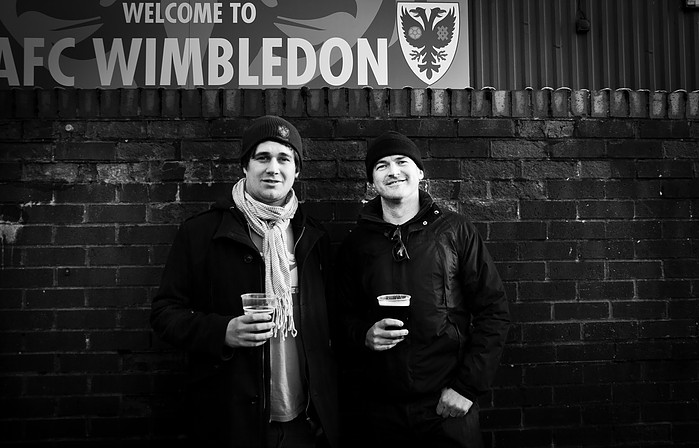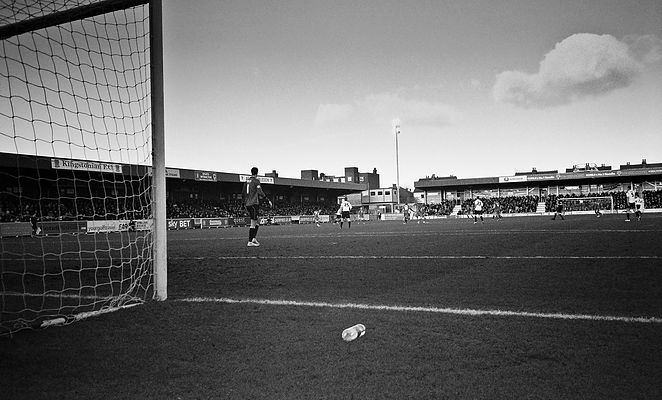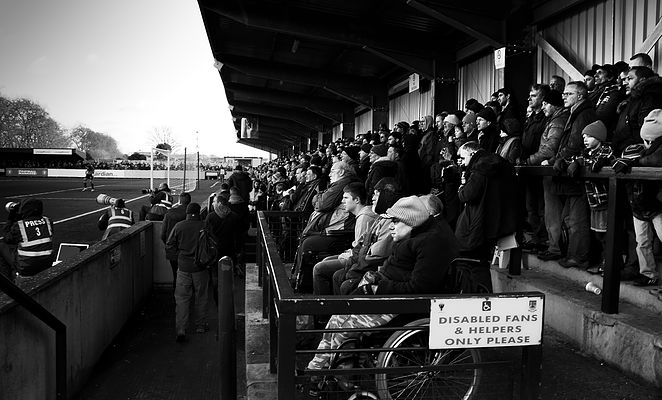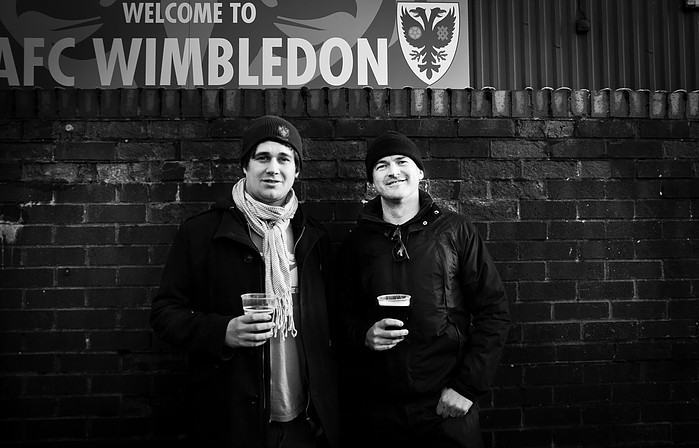A dérive in-and-out of London with AFC Wimbledon
Story and photos by Zak Varvaresso – Interviews by Giovanni Rumma
A tale of two footballs
Woody Allen insisted on shooting some of his more mature films in London, where social classes were still distinct and therefore visible, unlike his beloved NY where the yoga trend has effectively worked for the elimination of classist discrimination. Granted, things in London recently seem to boil over but is still too hard to feel the breeze when it comes to the post-Olympic London City of real estate frenzy. Especially when you have to thank all those crispy executives who regulate their energy levels by jogging in the park for reminding you that you can still clock the machine age in their iPod screen.
I never had a soft spot for London. Having been assigned along with Giovanni to work on an article about the social aspect of football spirit in the city, we weren’t exactly living it up as we were broke and not at all proud. Clustered around the Green Lanes area of Haringey along with fellow Turks we were hurting the soft tissue in our brain with spiteful thoughts taking it out on modern football: Arsenal’s old Highbury stadium had converted into modern flats, West Ham United was ready for a classy move into the new Olympic stadium, Fulham’s ownership had shifted from Harrods towards the big partners in mother America and undoubtably the world would be a better place without Chelsea on the map. Modern football pattern story was repeating itself in the city which has launched modern labour movement and studies in postmodern. John -one of Humba’s magazine editors in charge- set us straight:
“Get outside the centre of the city and pick any Wimbledon’s game up you find!”
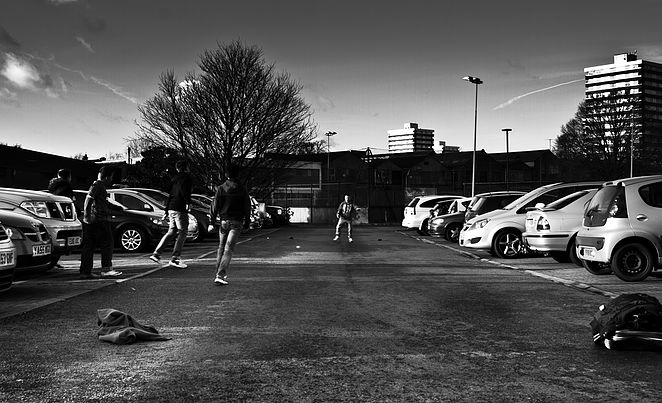
Crazy Gang it is
The iconic picture of Wimbledon’s Vinnie Jones grabbing tightly Paul Gascoigne by his testicles hooked me as a kid who always saw in asymmetric warfare a quite clever route to take down much stronger athletes. Salerno native -alike Gennaro Gattuso- and catenaccio aficionado Giovanni quite agreed. The story after all made sense under the sound of “Which side are you on” on you tube. Although when you mention the name of Wimbledon one of the world’s most celebrated tennis events springs to mind, once there was also a football team that featured a band of misfit players like Dave Besson, Denise Wise, Lori Sanchsez and Vinnie Jones, who were so wild that notoriously were known as the Crazy Gang. FC Wimbledon founded in 1889 in southwest London and from 1986 to 2001 competed in the Premier League performing surprisingly well and pulling off one of the greatest FA Cup final upsets in modern history by famously beating mighty Liverpool in the 1988 final.
Those players were the underdogs of the league who would put the rules of modern football etiquette under threat, focusing on extreme physical and defensive plays as they would literally fall against their opponents with the whole core of their body in order to proceed. These aesthetic dimensions of the Dons game seen as an expression of working class ethics have been central to the teams blue collar fan identity and played into one of the fundamental aspects of the team supporters pride and community strength. Sadly, by the late nineteens the glory days were gone and the team went bankrupt entering what became a long period recession.
The new owners decided to rebrand their product and renamed the club Milton Keynes Dons relocating it to the homonym new town in Buckinghamshire, thousands of miles far away from its historic ground to a new 20,000-capacity arena.
That was the tipping point for the romantic fans who decided to take extreme measures not just against their owners but against the whole machine.The time had come for things to evolve aside from the corporate immune system. In 2002 a group of diehard Wimbledon fans formed a phoenix version of the club, based in Kingston in southwest London.The new fan-owned AFC Wimbledon has been promoted from the ninth tier (Combined Counties Premier) to the fourth (League Two) over the past 9 years wearing always yellow and navy blue and the badge of the black double-headed eagle on the chest. The team is still running by the fans and manages to survive the economic pandemonium which has plagued the league making it’s “against modern football” statement loud and clear like a chant sung in full voice from the stands.
“What we do is what we are”
The air got so much colder within one and half hour as we were heading to Kingsmeadow in southwest London, the small provincial football stadium of AFC Wimbledon. While on the bus we were doing impromptu ethnography, observing people wearing their team scarves, looking somehow far beyond the hip façade of the centre. As we reached the iron gate of the stadium we found tucked away in the corner a crowd of fans in yellow and blue, countless beer cans on the lawn, pavement stalls with antique football memorabilia for sale and a prematch show of kids kicking the ball in the parking lot with public housing projects serving as background image attachment. Surrounded by lots of women of all ages drinking their beers and talking about the upcoming match, a big warning sign informed us that “no slogans of sexist and racist content were accepted”. A clear reminder of football as a dominant symbol of masculinity and an overcoming-challenge for a community team who dares now to do things differently.
As soon as we got the media coverage permission we started scooping around. Two siblings in their thirties smoking under the stone boundary walls immediately got the point and started recounting the story:
“Fans were sad when the team moved away from it’s home ground. In the first years we were struggling for economic survival and I can’t say we did enjoy the game. Twelve years later this sense of negativity is gone. As we keep running the team money has always been an issue. But when it comes for something important we always find a way. Some fans have donated great amounts of money in the past for a transfer without the expectation of getting something back…Something like a gift for the team. Of course we aren’t Barcelona…Yet!”
We make room for the other brother:
“We are 400 fan members, one member, one vote. We vote every 2 years and form a seven-member committee who takes the charge. It took us 9 years to reach a professional level but we started from the bottom and we saw all the work it had to be done. And that was a great experience for us. Now we hope in two or three years to return home. The team is running by the fans for the fans, but you have to do the work!”
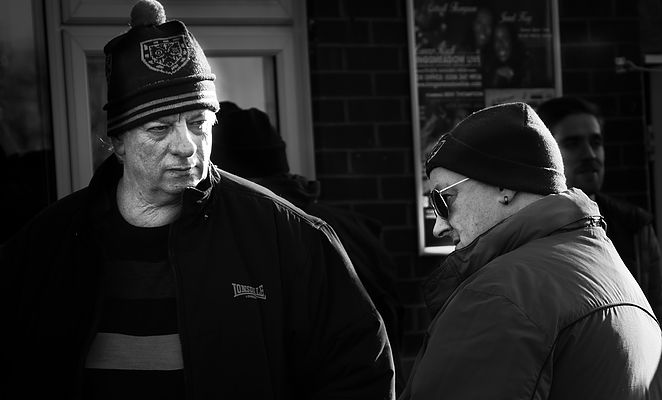
Back in the corner we spotted out the key figures of 60 year old Ernie and John. Ernie went further back:
“We have been supporting Wimbledon for fifty years. In 1964 I first saw Eddie Reynolds -the legendary striker of the Dons- playing for a fa cup match. A bunch of managers got us at the bottom and this was a valuable lesson for us. We must not forget and let it happen again. But we had lots of things going for us those years. It took us almost a decade to reach where we are, but this is football … “
“The fans proved what they can do. We don’t need managers. What we do is what we are! ”
John gives the proper ending to the narration. Fans start singing:
“Take me home Wimbledon, take me home, Oh South London, Oh South London, It’s wonderful, It’s wonderful “
and the game gets under way.
Made in England
Thousands of fans at Kingsmeadow give 400 rivals of Accrington Stanley who turned up for the game from Lancashire a warm welcome applauding them. The atmosphere igoes retro. I put my digital camera aside, load a 35mm film on my Nikkormat and take place behind the goalposts of the opponent team. As the players are doing their warm up, I spot Adebayo Akinfenwa aka the beast famous for being Europe’s heaviest footballer. Wimbledon always had a way to be outside the norms. The referee blows the whistle and the stand makes the traditional fun of the goalkeeper:
“Dodgy dodgy keeper…How you go for work everyday in this shape? You’re getting sacked in the mornin’g!You look like the greatest failure in the world.”
The kipper can only laugh at it by doing a mocking clap. This is fun! A reminder of a basic pleasure from childhood strikes me: There is no reason watching the game alone through the lens . I take the last shots of the film and go immediately at the standing area, finding Giovanni being tutored the teams chants by a bunch of local youth fans. Akinfenwa runs like hell, splits the defence and creates a lot of space as George Francomb is running up and down the flanks constantly beating players down the sideline. Wimblendon are on their way as Sean Rigg turns in a Francomb cross to open the score in time. Football fever really takes off, sending fans into a frenzy and the stand transforms into a luna park coaster. We get lots of hugs from women and men as we try to remember the chants we have just learned in absolute vain.
“Wise men say, Only fools rush in, But I can’t help Falling in love with you! Wombles! Wombles! Wombles!”
When 1000’s of people all want to use the bathroom at the same time standing in the line it is something called Half-time of the game. As we wait in anxiety, we observe dozen of cheerful fans using the urinals chattering away and singing. A basic aspect of the English social structure consists of people growing up in fraternities: They learn from their youth to pee together, sing and drink together, play sports together, return to their houses and the other day to go to work. System always functions both ways and Half-time is not always a waste of time.
The second half is underway and when the linesman raises his flag he gets an open letter from a frustrated fan. I try to read his lips:
“Mr Linesman, I really really disagree with you!”
Typical Brits. Adebayo Azeez doubles Wimbledon lead a few minutes after and the whole issue is forgotten. As night falls, Accrington Stanley tries to claw their way back into the game, grabbing a consolation through Adam Buxton, but it is already too late. The final whistle blows and some fresh air along with tobacco smoking help clear our mind out of the intensity of the game.
We head to the team store to support the cause spending our last money on a Wimbledon scarf, as a gift forJohn. The crowd dissolves fast into the darkness as hundreds of people wait for the bus preparing themselves for Monday job. Morning workout routine in parks doesn’t seem to be a doable option for these type of Londoners .
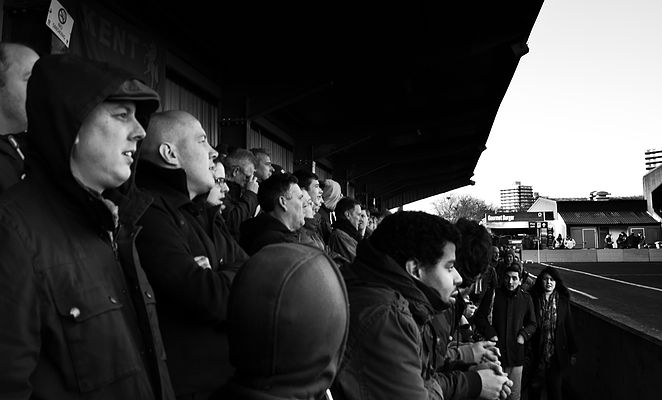
The suburb gets deathly quiet as we keep looking for the valuable Oystercard in our back pocket waiting for the bus to pass. The last thing we need is going back into the distracting frenzy of London City but we have no desire to walk through the night out there. We catch ourselves carrying a sense of grief but we feel too numb to admit it.
On the way back on the train as we try to get adjusted to city reality, the sincere snapshot of communalism we have experienced keeps coming back. We phone John to pass along the news
” So you spent your last money on a scarf. Well, news to me…I have already two of them. Wellcome to Wimbledon…”
Photo story: AFC Wimbledon vs Accrington, 24 January 2015
Published in Greek by “Humba” Magazine – Issue 20, June of 2015
Published in English by “Thin White Line” Magazine – Issue 4, October of 2015
The story in pictures
This slideshow requires JavaScript.


